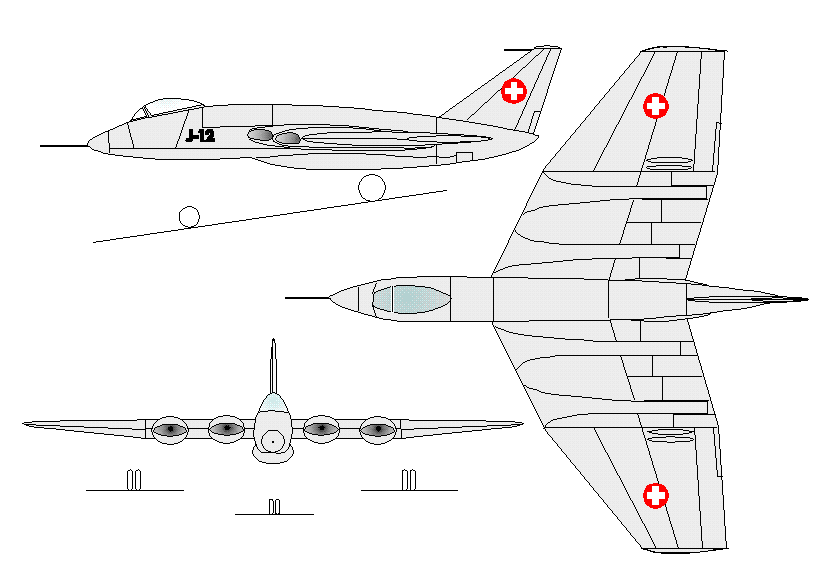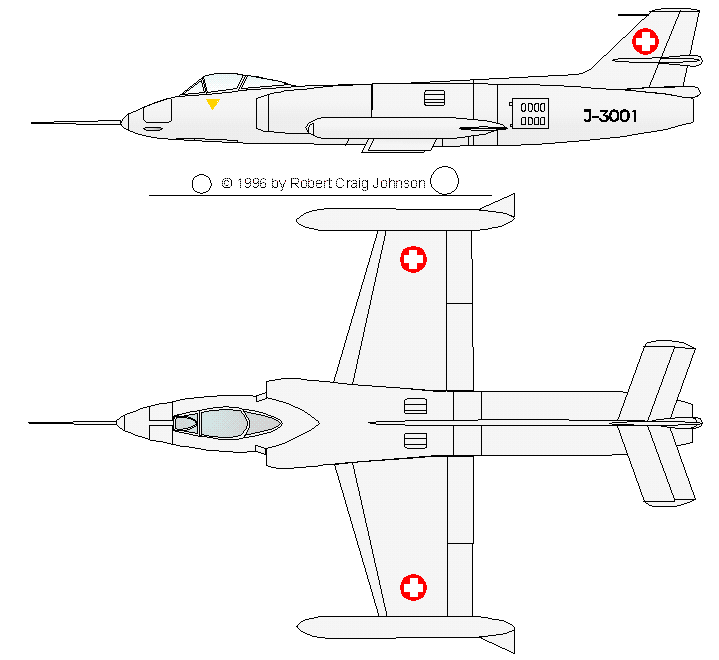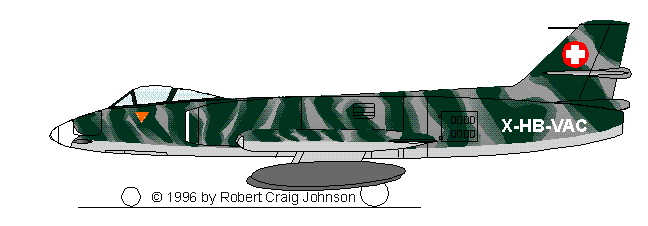
During World War 2, Switzerland defended her neutrality with a combination of imported and domestically designed aircraft. The Swiss government purchased Messerschmidt-built Bf 109s and obtained a production license for the French Morane-Saulnier MS.405 and 406 fighters. The Dornier-Altenrhein factory supplemented this foreign equipment with its own D-3801, D-3802, and D-3803—highly modified, advanced developments of the MS.406 powered by high-output, re-engineered Hispano HS12Y engines. The EFW concern supplied the Flugwaffe strike element with the unique C-3603/C-3604 design. This was a sleek, low-wing, single- engined, two-seater with twin tail fins, a 20-mm Hispano moteur-canon, 7.5-mm machine guns, and light bombs. Examples re-engined with turboprops towed targets for Swiss flak crews well into the early 1980s.
Militant, armed neutrality leavened with a fair bit of collaboration was enough to save Switzerland from the destruction that overtook so any of her European neighbors. The nation became rich in the process. But, for Swiss aviation, neutrality had its cost as well. While Swiss industry performed prodigies, turning the slow, elderly MS.406 into a 422-mph fighter and the archaic, 850-hp HS12Y into a 1500-hp, fuel-injected marvel, Switzerland was perforce isolated from the aeronautical mainstream. Her engineers were largely ignorant of the portentous wartime discoveries of the combatant powers: electronics, rocketry, and jet propulsion. When war ended in 1945, the Swiss confederation was, in short, woefully deficient in the technical expertise that her defense would require in the new era.
Painfully aware of these new realities, the Swiss Federal Aviation Factory at once set out to make up for lost time. The company began work on an ambitious, radically innovative new fighter, the N-20 Aiguillon ("Sting"). The N-20 was a tailless, swept-wing airplane reminiscent of the US Navy's Vought F7U. The Swiss fighter had only a single fin and rudder, however, and no less than four engines.
A three-fifths scale demonstrator flew successfully in 1951. This Arbalete ("Crossbow") was powered by four tiny, 242 lb-st Turboméca turbojets mounted in vertically stacked pairs above and below the wing on either side of the fuselage. The airplane spanned 24 ft. 10 in. and could reach a maximum speed of 466 mph, an astonishing performance given its modest power.

The full-scale N-20-01 prototype emerged soon after. It had four low-bypass SM-01 turbofan engines, among the first of their kind anywhere. These engines were derived from the Armstrong-Siddeley Mamba turboprop and produced about 3300 lb-st each. They got the little fighter off the ground briefly during taxi tests. But then the program was abruptly cancelled. Perhaps there were technical problems. Or perhaps the Aiguillon simply fell victim to the notorious parsimony of the Swiss parliament (Swiss bankers did not get rich by not knowing what things cost). Be that as it may, Switzerland's first jet fighters—DH100 Vampires—came from Great Britain.
The FFA P-16 was a technically less daring but better thought-through project, tailored to the needs of the post-war Swiss forces. FFA's Altenrhein-based design team set out to design a transonic replacement for the obsolete, piston-engined D-3802 and C-3604 aircraft then serving in the close-support role. The airplane was to be a single-seater. It would be able to fly in and out of short strips in narrow, high- mountain valleys. STOL performance, responsiveness at high speeds and low altitudes, high installed power, and first-rate low-speed handling were thus essential. Two prototypes were ordered in 1952.

The design that emerged was notable for its unusual, low aspect-ratio wing, large wingtip fuel tanks, and extensive high-lift devices: full-span leading edge flaps, large trailing edge Fowler flaps, and interlinked, drooping ailerons (the wing design was later adopted for the famous Learjet business aircraft). Power was supplied by the 7900 lb-st Armstrong Siddeley Sapphire 6 turbojet used in some models of the Hawker Hunter. Heavy duty landing gear with twin wheels and tires at all stations absorbed the high sink rates and rough ground that would be encountered during operations from high alpine fields.
The first prototype (military registration J-3001) flew in April 1955. Performance proved excellent. But after only four months and 12.5 hours total flying time, a fatigue failure in a small pressure fitting caused the aircraft to crash into Lake Constance, killing its pilot.
The Swiss authorities nonetheless awarded FFA a full-scale development contract for four pre-series, production-standard aircraft. The first of these, J-3002, flew in June 1956. It had longer engine air inlet trunks, rear-fuselage air brakes, and braking chute planned for the definitive, operational airplane. It also carried gun armament. A third prototype, J-3003, appeared in 1957. This aircraft introduced the uprated, 11,000 lb-st Sapphire 7 engine. Tests went well, and, in 1958, the Swiss parliament committed itself to the purchase of 100 P-16 Mk.3 tactical fighters.
This legislative decision was controversial and closely fought, however, like many later Swiss military procurement programs. When the third prototype crashed after its pilot failed to respond to an otherwise minor hydraulic problem, parliament reversed itself and cancelled the entire order. In a face-saving gesture, the government alleged that the program would be too long delayed pending redesign of the control system.
FFA did not give up immediately, however. It could hardly afford to. The company completed a fourth and fifth aircraft at its own expense in July 1959 and March 1960. The two fighters flew under civil registrations, X-HB-VAC and X-HB-VAD respectively, but were in other respects full military production articles. Both carried a full range of armament, and X-HB-VAC was camouflaged. The production P-16 spanned 36 ft 7 in for a wing area of 322,92 sq-ft. It was 46 ft 11 in long and stood 14 ft tall. Empty weight was 15,520 lbs, loaded weight was 20,503 lbs, and maximum overload weight 25,838 lbs. A total of 550 Imp. gal of fuel was carried internally and in the fixed tip tanks.

The P-16 was armed with two nose-mounted, 30-mm Hispano-Suiza HS 825 or Oerlikon KCA cannon (of the type later used on the SAAB JA-37 Viggen), each with 120 rpg. These guns were formidable, high-velocity weapons developed originally for ground-based antiaircraft use. They fired a shell 50% heavier than the Britsh ADEN or French DEFA of similar caliber and at such a high velocity that the gun was seriously considered as an alternative to General Electric's GAU-8 Gatling during the early years of the A-10 program. A retractable MATRA launcher for 44 x 68-mm folding-fin rockets filled the space between the guns, though two additional cannon could replace the rockets if desired. Up to 5000 lbs of bombs, napalm canisters, and 80-mm Oerlikon SURA rockets could be carried on ten underwing pylons.
At sea level, the P-16 could reach 710 mph. At 26,000 feet it could maintain Mach 0.92, or Mach 1.1 in a shallow dive. Climb rate was 12.795 ft/min. The crucial STOL performance was lkittle short of amazing. The P-16 could take off and land in only 547 yards. This compares well with the Hawker Hunter's 1090-yd takeoff run and 740-yd landing roll and with the DHC-5D Buffalo STOL transport's 327 yd takeoff. Stall speed was 115 mph. Range on internal fuel was 920 miles at 36,000 ft.
It seems a shame that the P-16 did not have better luck. It was a stellar performer, it carried a weight of armament seldom seen in its day, and it met all Swiss requirements. Combining, as it did, the virtues of an A-10 with the speed and excess power of a transonic fighter, the P-16 could still have been effective today. With its costs safely amortized over 30+ years, it would even have been cheap in comparison with the succession of ill-suited DH Venoms, Hawker Hunters, and Northrop F-5Es that have served as stop-gap ground-attack airplanes up to the present day.
Text © 1995 by Robert Craig Johnson. Art © 1997 by Robert Craig Johnson.